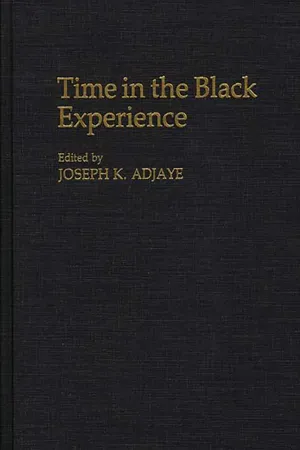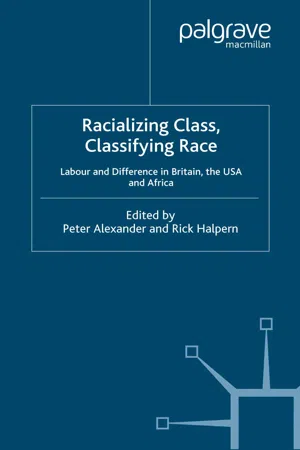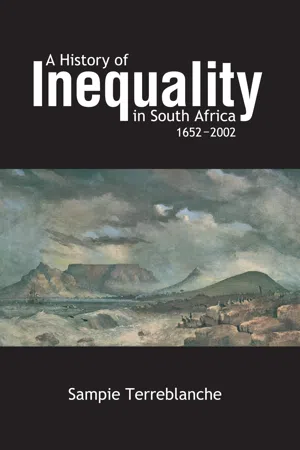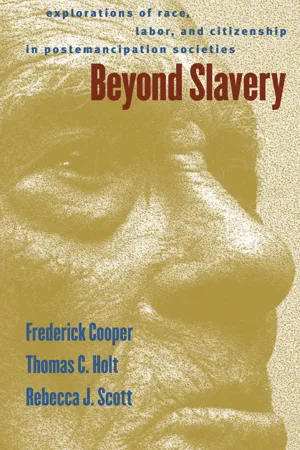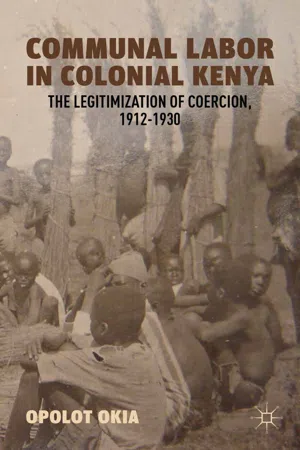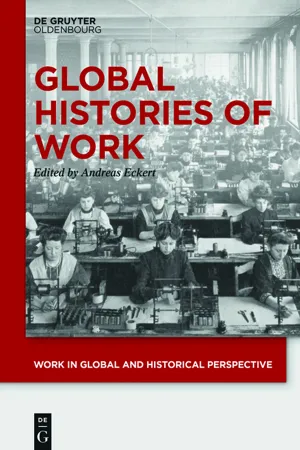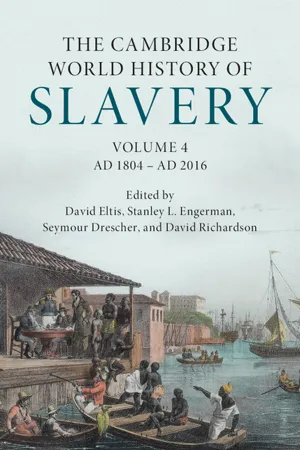History
Labor Systems in Africa
Labor systems in Africa historically encompassed a variety of arrangements, including kin-based labor, slavery, and tribute labor. These systems were shaped by factors such as social organization, economic needs, and interactions with external forces. The impact of these labor systems on African societies and their long-term legacies are subjects of ongoing scholarly inquiry.
Written by Perlego with AI-assistance
Related key terms
1 of 5
8 Key excerpts on "Labor Systems in Africa"
- eBook - PDF
- Joseph K. Adjaye(Author)
- 1994(Publication Date)
- Praeger(Publisher)
All these are aspects of African labor that have received quite extensive coverage in various his- torical treatises on colonial Africa. 1 Less recognized, perhaps, was the colonial need to "regiment" African labor, to canalize it into a disciplined routine for maximum pro- ductivity. Colonial authorities were wont to regard African labor as lack- ing in commitment to regularity and the discipline that necessarily goes with it. According to Lord William Hailey, African societies "had their own systems of economic organization, the obligations of which were well recognized; but the discipline of regular labour, which involved compliance with the orders of employers who had no traditional author- ity, was unfamiliar to Africans" (1957, p. 1358). Without this colonially defined discipline and regularity, African labor was deemed unlikely to attain a level of efficiency that would make capitalism truly triumphant on African soil. The concern, therefore, was not only to reduce African labor to the service of capitalism, but also (and more importantly, per- haps) to regularize and maximize its exploitation for capitalist profit. The motive force here was, of course, what Karl Marx called the "labor theory of value" in which time plays a central role: the value of a com- modity is seen in terms of the labor time put into its production. 2 However, for capitalist productivity to be truly successful, the amount of labor expended in the production of a particular commodity must not fall below a certain standard within a given block of time, and it is in this respect that colonialism became particularly concerned about the "undisciplined" and irregular nature of African labor. Colonialism had, in fact, succeeded in creating an African labor pool. It had also succeeded in putting that pool to work in the service of cap- italist production. - eBook - PDF
Racializing Class, Classifying Race
Labour and Difference in Britain, the USA and Africa
- P. Alexander, R. Halpern, P. Alexander, R. Halpern(Authors)
- 1999(Publication Date)
- Palgrave Macmillan(Publisher)
The national labour market slowly became increasingly integrated and the barriers the local elites and communities put up around the integrity of parishes were eroded. In Africa, on the other hand, capitalists stood little chance of depriv- ing the population as a whole of access to land even if they wished to do so. Struggles over primitive accumulation were tenacious, even in South Africa where the institutions available to the state and capital were by far the strongest. Africans in many ways deepened their own attachments to their soil, their relations with each other, and their ways of producing and distributing commodities in defence against the encroachments of capital and the colonial state. Over the course of history, Africans paid a high price for their partial success in refus- ing to be reduced to labour power. The reinscription by colonial regimes, especially in the 1920s, of Africa as the continent of tribes was to a significant extent a reaction to the fact that their quest to detach labour power from its social roots had failed. The strategies of African workers which so frustrated colonial states depended not simply on their sense of ‘community’, but on mobility and the broad- ening of affiliations; geographic and cultural flexibility was more useful than boundedness and fixity. The colonial regimes sought to Categories, Boundaries and Connections in the Study of Labour 227 turn a flexible landscape into a series of iron cages known as tribes. In so doing, they gave particular power to male elders – who were doing their best to manipulate colonial officials’ need for their cooperation – in keeping tabs on women, young women in particular. 23 These transformed gender relations were also intrinsic to the spatial system in which viable, but hemmed-in, African agricultural zones were linked via oscillatory migration to wage labour areas. - eBook - PDF
- Sampie Terreblanche(Author)
- 2002(Publication Date)
- University of KwaZulu-Natal Press(Publisher)
We can indeed argue that the social and economic history of modern South Africa has been one of unequal distribution of power. The country’s history during the periods of colonialisation, segregation, and apartheid (1652–1994) will be discussed in part 3 (ch 5–9). Any endeavour to explore the history of unfree black labour requires a thorough exploration of how power and authority have manifested themselves in successive systemic periods. This book is concerned with the structuring forces of colonialism, imperialism, and white political and economic domination, but more specifically with how these structuring forces deprived indigenous people of their land, and reduced them to different forms of unfree labour. Consequently, it is necessary to concentrate on the ways in which power – and especially white-controlled power – has been mobilised, maintained, legitimised, and institutionalised in different periods. We can distinguish between the following six systemic periods in South African history: i The mercantilistic and feudal system institutionalised by Dutch colonialism during the second half of the 17th and most of the 18th century (1652–1795). During this period the Trekboere created a semi-independent feudal subsystem, with its own power and labour relations. But this feudal subsystem was not fully independent, and must therefore be regarded as part of the Dutch colonial system (see ch 5). ii and iv The systems of racial capitalism institutionalised by British colonialism and British imperialism during the ‘long 19th century’ (1795–1910). The legal, political, and economic patterns introduced by the British destroyed the mercantilistic, feudal, and traditional patterns of the PART 1: POWER, LAND, AND LABOUR 1 4 Dutch East India Company, the Afrikaners, the Khoisan, and the Africans in that order. - eBook - ePub
Beyond Slavery
Explorations of Race, Labor, and Citizenship in Postemancipation Societies
- Frederick Cooper, Thomas Cleveland Holt, Rebecca J. Scott(Authors)
- 2014(Publication Date)
- The University of North Carolina Press(Publisher)
2 French officials now tried to bring to bear in Africa the knowledge they had acquired in containing the demands of workers in the metropole. They were immediately challenged within the very framework through which they sought to reestablish control—by assertions from a labor movement that if officials expected Africans to work like Europeans they should be paid like Europeans. Yet the idea of the African as “industrial man” left as many problems obscured—the specificity of the social conditions out of which workers emerged, the family arrangements they might seek to make, the part the wage labor would play in the life cycle—as they seemed to clarify. What kinds of social policies would be imaginable and inconceivable in “modern” Africa and who should set those policies? The question of what lay beyond colonial labor policies weighed just as heavily on African labor movements and African governments in the 1960s as the question of what lay beyond slavery lay on former slaves, former slaveowners, and state officials in the British West Indies in 1838 or in the French Antilles in 1848.The concern chapter is the framework for understanding labor that exploded in the late 1940s, which itself grew out of the uneasy “beyond” that the emancipations of the previous century had left.3 The critiques of slave labor that had emerged in late-eighteenth- and early-nineteenth-century Great Britain—and less consistently in France and other European states—were in many ways remarkable in their scope, endurance, and significance. The powerful universalism of free labor ideology—linked to the realities of European military and economic power—has confronted Africans and their descendants with a compelling set of images: the idea of a self-motivated, self-disciplined worker, making choices in a labor market and thereby determining the welfare of his or her family. It has been hard for laborers to be cultural relativists, to insist that punctuality, diligence, and obedience were peculiar European folkways. The power to label in international debates has by and large gone the other way, and it has been the work habits of the African that have been labeled peculiar, while market-discipline has been discussed as an acultural, universal norm.4 - eBook - PDF
Communal Labor in Colonial Kenya
The Legitimization of Coercion, 1912–1930
- O. Okia(Author)
- 2012(Publication Date)
- Palgrave Macmillan(Publisher)
4 C h a p t e r 1 Forced Labor and Colonial Development in Africa As European powers began to assert hegemony in much of Africa during the early twentieth century, forced labor became a common and cheap method of organizing the labor of colonial subjects. The impoverished colonial states needed cheap African labor for infrastruc- ture development while, in settler colonies, European immigrants and business interests also required affordable labor to squeeze out profit margins. 1 The myth of the lazy African male, unresponsive to eco- nomic incentives and lethargic due to the labor of his womenfolk, fueled the ideological justification for forced labor as an aspect of pro- gressive rule. 2 Essentially, if Africans would not work for Europeans, which was in their best interests anyway, they must be forced to work. Out of this moral and economic “dilemma” of development grew the multiheaded Hydra of forced labor in Africa: forced labor for pri- vate interests, government forced labor, and coercion in the interests of community. In this chapter we first, broadly, examine the general archetypes of forced labor in colonial Africa and their connection to economic development. Forced Labor for Private Interests Historically, Africanists have paid more attention to forced labor for private purposes due to its more immediate association with the slavery. 3 During the early period of colonial rule, in areas with sig- nificant European settlement, private sector demands for inexpensive African labor were high. However, the wages were dreadfully low, the work was arduous and dangerous, and many Africans still maintained Communal Labor in Colonial Kenya 10 access to their means of production: land. With this state of affairs, the strong demand for labor was not neutralized by an equally robust sup- ply. This situation only increased the pressure for conscription. Enter the state. Through taxation, many Africans could be compelled to work. - eBook - PDF
- Andreas Eckert(Author)
- 2016(Publication Date)
- De Gruyter Oldenbourg(Publisher)
And religious formations are of course eminently global with their claims to universal community, in the reach and technological sophistication of their propaganda: sometimes harnessed to nationalism, reli-gious aspirations can also subvert the nation-state project with claims to a global community and project. South African labour, or labour in South(ern) Africa? A transnational perspective can make an important contribution to the labour history of southern Africa, where scholarship on labour history is unevenly developed in the region, concentrated in South Africa, and generally been placed within the framework of the nation-state. Labour history in South Africa has derived from two main traditions: activist and scholarly work. Activist writing on labour, largely produced outside of academia, goes back to the 1920s. The earliest work came from white labour (Gitsham and Trembath 1926; Walker and Weinbren 1961), followed by writings by Communist Party of South Africa (CPSA) members in the 1940s (Andrews 1941; Cope c. 1943; Harrison n.d.; Roux [1944] 1993), Trot-skyist analyses in the 1950s (notably Majeke 1952; Mnguni 1952; Tabata 1950; for a partial overview, see Nasson 1990), and a wave of works by writers associated with the CPSA’s successor, the South African Communist Party (SACP) from the 1950s onwards (for example, Bunting 1975; Forman [1959] 1992; Lerumo 1971; Simons and Simons 1969 [1983]; for a partial overview, see Drew 1997).3 3 The work of Baruch Hirson, exiled South African Trotskyist, on the history of labour and the left, can also be usefully placed within the activist tradition: for a partial compilation, see Hirson and Hirson (2005) and also see Hirson (1989). Rethinking Worlds of Labour 103 Leaving aside a few liberal analyses of labour that had some historical content (Horrell 1969), the scholarly tradition of labour history emerged in the 1970s in British and South African universities, and was influenced by Marxism and class analysis. - eBook - ePub
Slavery and Resistance in Africa and Asia
Bonds of Resistance
- Edward A. Alpers, Gwyn Campbell, Michael Salman(Authors)
- 2013(Publication Date)
- Routledge(Publisher)
Introduction: Slavery, Forced Labour and Resistance in Indian Ocean Africa and Asia 1 Gwyn Campbell and Edward A. AlpersHistoriographical Background
Conventional Western historiography based on the Atlantic slave system has characterized the slave as a chattel who could be sold or transferred at will by the owner, and a capital asset who, through coercion, bore dividends both in productive labour and through reproduction. Some authors have considered that economies in which slave labour predominated were characterized by a ‘slave mode of production’. The slave/free divide, the major social division in slave-owning societies, was accentuated by the slave’s legal inferiority and his/her foreign and allegedly uncivilized origin. Only in exceptional cases was a slave granted freedom. Again, conventional historiography portrays the forced labour policies of colonial regimes as highly exploitative, fomenting resentment, the formation of nationalism and a desire for independence.In such historical contexts, rebellion was to be expected. This is because there comes a point of exploitation at which the slave or unfree worker has nothing to gain from complying with the labour system he/she is subject to, and nothing to lose by rebelling against it. Thus there developed a vast range of reactions, from passive resistance to marronage and outright revolt. However, it is clear from this and other recent studies on slavery and unfree labour in Asia (including aboriginal Australia) and Indian Ocean Africa (IOA)2 that the range of reactions to forced labour regimes by those subject to them were much more varied than those presented in conventional literature on slavery.3 - David Eltis, Stanley L. Engerman, Seymour Drescher, David Richardson(Authors)
- 2017(Publication Date)
- Cambridge University Press(Publisher)
Its incidence had fluctu- ated over time with its periods of dominance usually associated with the rise of empire and military hegemony. Moreover, the major slave societies – those with economies that drew primarily on slave labor – usually obtained their slaves from regions outside their immediate imperial domains. Prior to 1800, societies had experienced the decline and even the disappearance of slavery, often accompanied by its replacement with terms of labor that most would regard as less severe. In Japan, it had ended by the early seventeenth century; in Russia slaves became serfs in the early eighteenth century, a phenomenon that had occurred in Western Europe several centuries earlier. But the countries in all these cases subsequently moved on to establish systems drawing on slave labor when presented with the opportunity to do so. Japan colonized the Koreans, European countries turned to Africa and Asia. European expansion both to the east and to the west was initially built on coerced labor. The source of that labor was non- European. The completely new feature about the post-1800 pattern of force in the workplace was the growing acceptance of its immorality in the imperial heartlands. This happened first in the Western Hemisphere, whether one locates the initial impulse in Britain, France, or Haiti, and introduction 15 then elsewhere, if the laws and constitutions of the 195 modern nations are any guide. Today, nowhere is slavery or any other form of servitude recognized as legal. Moreover, unlike the pattern at the time of abolition, when it was the ex-slave-owners rather than the ex-slaves who received compensation, the descendants of the freed people today are calling on the nations that enslaved their ancestors to pay reparations. There are two counter-examples to this interpretation represented in the present volume: one focusing on Islam and the other drawing on post- colonial scholarship.
Index pages curate the most relevant extracts from our library of academic textbooks. They’ve been created using an in-house natural language model (NLM), each adding context and meaning to key research topics.
